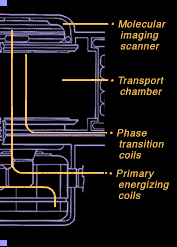

Cargo transporters work on a molecular resolution, whilst personnel transporters work on a much more accurate quantum resolution.
Personnel must use quantum resolution transporter systems, as molecular resolution transporters aren't accurate enough to transport life forms without loss of mental functions. Emergency transporters are equipped with high-volume scan-only phase transition coils, meaning that they can only be used to transport off the ship.
Typical
range of an emergency transporter is 40,000 km, depending on power availability.
Starships
equipped with transporters incorporate a series of several transporter
emitter pads along the hull. These emitters provide long-range virtual
focus molecular imaging scanners and phase transition coils.
Transporter Systems Operation
Transporter operations can be divided into these four major stages:
1. Target scan and coordinate lock:
This is the initial phase when the destination co-ordinates are programmed into the transporter system. The target scanners verify range and relative motion, as well as checking the atmosphere is suitable and the validity of the target (to ensure that personnel don't beam into a rock or something). At this stage the transporter system runs a low-level diagnostic on itself.
2. Energize and dematerialize:
The molecular imaging scanners derive a real-time quantum-resolution pattern image of the transport subject whilst the primary energy coils and the phase transition coils convert the subject into a subatomically debonded matter stream.
3. Pattern buffer Doppler compensation:
The matter stream is briefly held in the pattern buffer, which allows the system to compensate for the Doppler shift between the ship and the transport destination. The pattern buffer also acts as a safety device in case of system malfunction, allowing transport to be aborted to another chamber. Captain Scott, formerly Chief Engineer of the Enterprise 1701 to 1701-A trapped himself in a deliberate transporter loop when his ship, the USS-Jenolen, crash landed on the surface of a Dyson-sphere. He was found over 70 years later by the USS Enterprise NCC-1701-D.
4. Matter stream transmission:
The matter stream is transmitted, within an annular confinement beam, to the transport destination through one of the ship's transporter emitter pads. The matter stream is re-assembled into the subject on arrival, as the annular confinement beam re-bonds the matter stream on a sub-atomic level.
System Components
Transport chamber:
This
is the protected volume within which the subject is de/re-materialized.
The chamber platform is elevated above floor level to reduce the possibility
of dangerous static discharge.
The
transporter platform floor in ST:TNG is made from the ceiling of the transporter
room from TOS.
This is where the Transporter Technician to program the transporter system. The three sliders on the original console have been replaced with three pressure sensitive bars on ships with the modern LCARS system.
Transporter Controller:
This dedicated computer sub-processor is located to one side of the transport chamber. It monitors and manages the operation of all the transporter's systems.
Primary Energizing Coils:
Located
at the top of the transport chamber these coils create the Annular Confinement
Beam (ACB) which creates a spatial matrix within which the de/re materialize
process occurs.
A
secondary field holds the transport subject in the ACB, as a disruption
of the ACB during the early stages of dematerialization can result in a
massive energy discharge.
Phase Transition Coils:
These wide-band quark manipulation field devices accomplish the de/re materialization process by partially de-coupling the binding energy between subatomic particles.
Molecular Imaging Scanners:
Each upper pad incorporates 4 redundant sets of 0.0012µ molecular imaging scanners at 90º intervals around the primary pad axis. Each scanner is offset 3.5 arc seconds from the ACB axis, permitting real-time derivation of analogue quantum state data using a series of dedicated Heisenberg compensators. This quantum state data is not used when transporting objects on molecular resolution.
Pattern Buffer:
This superconducting tokamak device delays transmission of the matter stream so that the Doppler compensators can correct for relative motion between the emitter array and the target. A single pattern buffer is shared between each pair of transporter chambers. Operating rules require at least one additional pattern buffer to be available in the system for possible emergency shunting. In emergency situations, the pattern buffer is capable of holding the entire matter stream for up to 420 seconds before pattern degradation occurs.
Biofilter:
Normally used only in transport to a ship, this device scans the incoming matter stream looking for patterns corresponding to known viral and bacteriological patterns. Upon detection of such a pattern it is removed from the incoming matter stream.
Targeting scanners:
A
set of about 15 of these is located throughout the ship's sensor arrays.
These devices determine the transport co-ordinates, including bearing,
range and relative velocity.